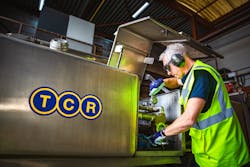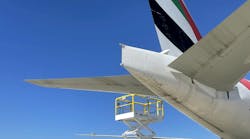Commercial airline operations need to run efficiently to be as cost-effective as possible. An airline’s efficiency relies on dependable ground support equipment (GSE) being available. So, it is imperative for ground handlers and service providers to implement a useful preventative maintenance (PM) program to keep GSE in service.
Utilizing technology, resources and planning tools to improve PM programs can keep maintenance-related overhead and expenses low.
When creating a PM schedule, Craig Ward, operations director at TCR, explains the starting point is hours of use.
“From here, we derive all points of maintenance planning, frequency, service types and so on,” he explains.
“A good GSE preventative maintenance program should track several items. The most important thing is tracking the interval between PM services,” adds Tom Kor, national manager at Global Aviation Services LLC. “This can be tracking by hours or days, but it should be consistent with the OEM recommendations for PM cycles.”
Officials at Global Aviation Services, which was recently acquired by aviation services provider PrimeFlight Aviation Services, note PM intervals should be followed closely to ensure OEM warranties are valid and to extend the useful life of the equipment.
It is imperative to use the correct PM checklist to track maintenance, especially considering each piece of GSE will have specific PM requirements and safety standards.
“It is important to follow that PM checklist,” Kor advises. “This has a direct impact on the lifespan of the equipment. It is vital to follow a checklist and ensure each item is checked, changed and /or adjusted, as required, so that piece of equipment returns to service and remains in service.
“Most breakdowns can be prevented by doing a quality PM check.”
Ward notes checklist requirements are dependent on the individual GSE use. These are always bound to legal obligations, influenced by industry recommendations, such as IATA's Ground Operations Manual (IGOM), and will be adapted case by case.
However, in general terms, safety-related items and fluid checks tend to be required more frequently, and Kor explains many OEMs suggest monthly operational checks for their proprietary safety-systems installed on the equipment.
Although, each type of equipment is subject to the same maintenance requirements across a fleet, it does not mean each unit is being used equally.
This uneven use can lead to one of two outcomes, explains Wayne Cockburn, general manager at Avro GSE. On one hand, under-used equipment can come into the shop and undergo a PM task that isn’t yet needed. And on the other hand, a unit that gets used more could be past it’s PM schedule, which could lead to compliance issues.
“You’ve got that side which incurs an unnecessary risk to a handler, and you’ve got the other side, which incurs an unnecessary cost,” Cockburn says. “The way to fix this is to connect the data from that machine to the maintenance software.”
Technology
The importance placed on efficient PM programs has led GSE maintenance personnel to incorporate the latest technology, including telemetry and maintenance software, to streamline maintenance tasks and parts procurement.
“Similar to the automotive industry, GSE is becoming smarter in the use of technology,” says TCR’s Ward. “Via CAN bus systems and diagnostic tools, we gain a better view on potential issues and prevent them to avoid unnecessary costs.”
“With equipment maintenance, you’ve got two tools to carry it out,” adds Cockburn of Avro GSE. “You’ve got the equipment maintenance software, which is basically your equipment maintenance records. Then you’ve got the data out of the machine, which handles when the machine is serviced and how it’s serviced.
“They need to connect.”
Telematics, or telemetry, offer a real-time view on a unit’s usage. Installed on both motorized and non-motorized equipment, telemetry can be used to identify possible mechanical issues, help control damage and reduce poor operating methods, explains Ward, noting TCR partners with Targa Telematics for motorized GSE and with Sensolus for non-motorized units.
Officials at Avro GSE, which produces the Avro Tracker telematics system, note historical maintenance records, idle run-time and other equipment details are valuable to track, too.
“You have real-time data on the hours of your machine. You can feed that into your equipment maintenance program, so your program is pulling the machines in when they need to come in,” Cockburn says. “That’s the bigger challenge. Because they can check all sorts of data when it’s in the shop. But if it doesn’t need to be in the shop, that’s waste.”
Once data is harvested from the telemetry units, the information can be utilized by maintenance software.
“Using a system to track preventative maintenance schedules and completion performance is critical to a successful maintenance program as it ensures accurate tracking of all maintenance performed. This data can also be accessed to review trends and performance,” says Kor of Global, a PrimeFlight company, noting there are many Computerized Maintenance Management Software (CMMS) systems on the market today for the GSE industry.
Tronair is preparing to launch EBIS 5.0, in April. The latest update to the company’s GSE-specific software platform will be available for web browsers, iOS and Android, and incorporates more than 100,000 assets in over 600 airports for its 3,000-plus users.
In addition to assisting best practices, EBIS 5.0 integrates supply chain and uses telemetry data along with de-identified industry data to perform predictive analytics.
“Our typical return on investment just by having a world-class maintenance program is a pretty phenomenal,” explains Rick Agnor, director of business development at EBIS by Tronair. “You’re designing out your failures, maximizing your equipment and reducing your cost.
“You can schedule your maintenance based on real-time info,” Agnor continues. “What we found with telemetry, it’s so much more accurate than doing some sort of calendar-based maintenance, where you really don’t know the exact mileage or hours on that engine.
“This is a lot more focused.”
Agnor says GSE maintenance providers can also use other data, such as conveyor run-time on a belt-loader, to trigger maintenance events – offering more flexibility to track PM requirements.
Maintenance software can also assist with parts procurement. EBIS 5.0, for example, has integrated the supply chain with NAPA and Sage Parts allowing for real-time parts information and ordering.
“That’s pretty much an arm of your purchasing. They handle procurement, stocking all the parts and you pay for the parts at the point-of-sale. It gets you out of the inventory business,” Agnor explains, adding required parts are usually on site or nearby, and suppliers can utilize commercial aircraft to get products to their destination quickly.
“The better we plan our maintenance, the better we can manage our parts and availability,” adds TCR’s Ward. “The data retrieved on our fleet helps us to predict the usage of parts.”
EBIS 5.0 also seeks to enhance supply chain integration. In addition to a service provider’s own custom catalogue for a piece of equipment, EBIS offers their own industry catalogues and the Sage catalogue is accessible using the eSage platform.
According to Agnor, EBIS also wanted to give information on specific components and show the top-rated components within the industry. Then, with this information, maintenance personnel can schedule a PM task ahead of an expected failure.
“You’re designing out failures by selecting better components. We’re also showing you if they’re past their useful life,” Agnor says. “They can see the top failures. They can see the component issues. And then, as they’re working through the parts side of it, they can see some of the top-performing alternatives.”
Technicians
The proper PM tools also help personnel performing the maintenance. Providing key information to stay on top of maintenance needs is important but following through on those tasks are paramount.
“The best way to perform preventative maintenance with the lowest impact on out of service time is to have technicians that are dedicated to PM work. A skilled PM technician will have the parts, tools and equipment needed to perform a good PM check prepared beforehand,” says Kor of Global, a PrimeFlight company. “When that unit arrives in the shop, the PM can be immediately started and completed in as little time as possible while still ensuring all PM checklist items are accomplished.
“You can also complete PM work while the equipment is not in use. Depending on operational needs, that may not be feasible without running overnight maintenance, which comes with its own set of challenges.”
Maintenance software can help ensure technicians are performing work correctly and efficiently.
EBIS 5.0 developers chose React JavaScript – the same technology platform used by Facebook – to provide its users with a clean interface. The platform supports videos and can integrate technical service bulletins and their patent pending “tech tips,” which assists with technician training.
“The industry is really seeing a turnover in employees, and as a lot of leadership groups and technicians are aging out, some of the new technicians don’t have a full set of skills,” Agnor says. “We see video as a huge enhancement, both on training and tech tips and ways to improve the new technicians.”
The tech tip function is a collaborative feature. If a technician is having trouble with a piece of equipment and finds a favorable solution, that tech can publish instructions for other maintenance personnel to fix similar issues. Agnor notes tech tips can be shared privately within an organization or made public to all EBIS users to benefit the industry, as a whole.
Maintenance software can also track productivity of technicians, too.
“Part of this is really understanding your operation at a real granular level. It’s really big on technician cost and overall productivity – getting them the right part at the right time,” Agnor says. “We also want to give them feedback on how well they’re performing maintenance.”
Both telemetry and maintenance software can assist shop efficiency because of the real-time data and predictive capabilities provided.
“If you know you’ve got 10 pieces of equipment that are 10 hours away from that PM, then that affects your whole supply chain and your labor for doing that PM,” Avro GSE’s Cockburn notes.
“You get a view of what’s coming,” he continues, noting constraints in the shop can be avoided. “Everything is pre-prioritized.”
Agnor agrees, adding the key is to set up your equipment in a software system to have full knowledge of where assets are and other data like in-service dates, warranty info and maintenance needs.
“If the average meantime to failure is 41 days, and you have your maintenance check set at 60, you’re never going to design out that failure. You need to put your preventative maintenance ahead of that failure,” Agnor advises. “You can make some data-driven decisions.”
Continuous Improvement
PM programs should be reviewed regularly and adjusted as necessary.
TCR’s Ward says understanding the demands on the GSE unit and working out a workable plan between ground operations and maintenance is the key. This can be reviewed annually, although it is not something that needs to be changed every year unless the parameters of an operation changes dramatically.
“Understanding your usage and operational demand is essential for better planning and an optimal maintenance program,” Ward points out. “Limited downtime while increasing reliability through better maintenance practices is the outcome you want to achieve.”
Cockburn of Avro GSE also recommends an annual review of maintenance programs.
“Often stuff gets put into that program and it just rolls. In the meantime, things move on and manufacturers specify different points,” Cockburn says. “The biggest thing in there is having the ability to be flexible to tailor your maintenance to what’s actually required on that piece of equipment – being flexible to adapt and update as equipment evolves.”
GSE maintenance personnel can use advanced analytics provided by maintenance software to assist with PM reviews.
Agnor notes the EBIS solution offers snapshots of assets over specified periods of time. If a review is done annually, maintenance managers can assess how the equipment is performing.
“It will churn through a year’s worth of data, mine this information, put it out in a graph and say ‘these two assets, here, represent 50 percent of your spend,’” he offers as an example, adding technicians can then focus on key components or repairs and perform head-to-head comparisons.
“As you design out these failures, you can continually improve the process and develop those world-class maintenance programs and actually see if you’re making the right decision,” Agnor says.
As the GSE in a fleet ages, reviewing and updating PM frequencies can become more crucial.
“The age of the assets, the run-time per day and climate could all be considered when building a successful preventative maintenance program,” advises Kor of Global, a PrimeFlight company. “The importance of tracking PM intervals, and the need to complete maintenance on-time based on those intervals, has become more and more important with the changes and improvements in OEM designs and GSE specific upbuilds.
“Additionally, the way a tech completes a PM has evolved in more recent times. Techs have found efficiencies in completing PMs in an order that minimizes the number of times they need to leave the vehicle to get a tool or part,” he adds. “For example, a quality PM program will list all tools and parts required and lays out a specific flow around the vehicle to maximize efficiency, reducing the vehicle’s out of service time.”
Investing in maintenance technology may seem overwhelming, but Cockburn encourages ground service providers to consider it an investment versus the cost of outsourcing maintenance.
“There’s always the question of do you go third-party or do you have your own shop?” Cockburn says. “Unless you’re real small and in one base, typically your own maintenance works out considerably more cost effective.
“If you can integrate these tools and you do have your own maintenance location on site, every dollar you’re investing into your equipment maintenance software or your telemetry is coming back to you.”





